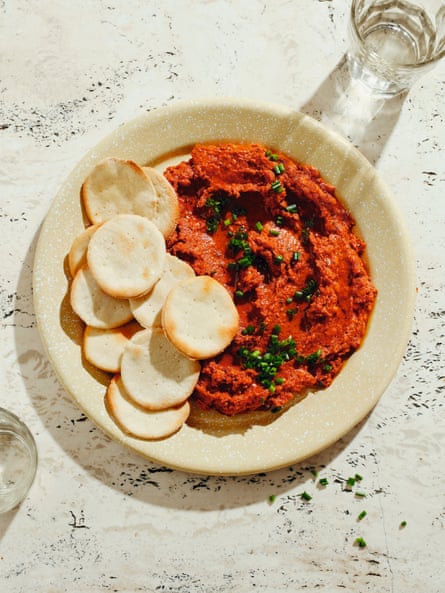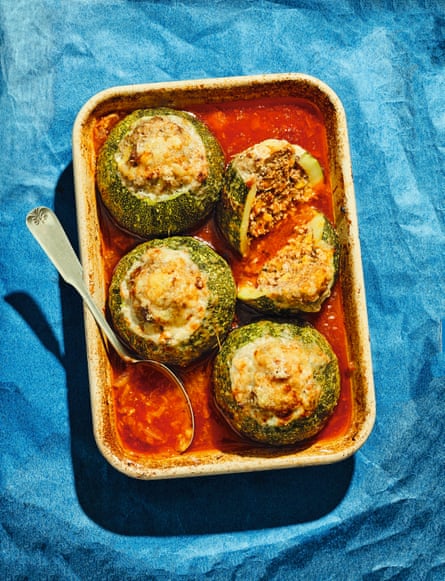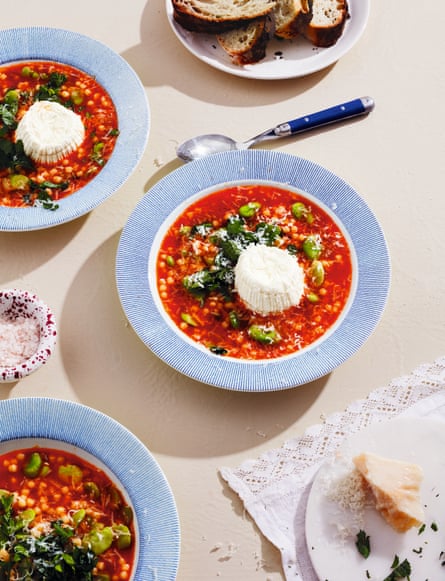Simon Bajada did not know much about his Maltese heritage when he was growing up in Adelaide. He was raised by an Australian-Irish mother and a father whose Maltese roots went “so far back” that he didn’t know the family’s origin story.
So by the time Bajada was researching his cookbook on Malta’s cuisine, he had a lot to discover about family and food.
“We would have these big lunches in Perth where Dad’s side [lived], and there’d be arguments about where things are from because of our connections to southern Europe, and this big community of Maltese-Egyptians we were a part of, because my grandfather was born in Alexandria,” he says.

But when he travelled to Malta, a lot of the culinary puzzle pieces fell into place. “[I] saw the love for Kunserva [a brand of tomato paste] and it all made sense at last,” he says. “My grandma used it like you wouldn’t believe, and we used to lick it on a spoon from the jar.”
He also found mint and spices – ingredients he often associated with Middle Eastern and north African cooking – in the local cuisine. But the biggest surprise, he says, was that even in summer on the archipelago, Maltese food tends to be on the heavier side.
“It’s surrounded by the sea, so you’d think seafood would be more prominent but it’s not,” he says. “It’s so accessible [that] it’s not considered special. What is considered special is hearty warmer dishes, which is weird because it’s a warm climate.”
A typical Maltese spread
Bajada says stews and big pots of soup “that get tapped into as the week goes on” are the mainstays of Maltese eating. During his travels he noticed one dish might spin off into a few forms: meat might be served as a main but its sauce would be cooked with marrows (large zucchinis) for a starter.
Though the table is often piled with smaller dishes: arjoli, tuna tomato dip; bigilla, a dip made of tic beans (similar to broad beans) and garlic; galletti, water crackers; ġbejniet, a sheep or goat’s milk cheese that might be served fresh, slightly dry and chalky, or preserved in vinegar and showered with cracked pepper; and perhaps a salad of white beans (fażola bajda bit-tewm u t-tursin) or cold octopus (qarnit bit-tewm).

His recipe below features tender octopus, plus fresh basil and parsley, red onion, tomatoes and garlic. A couple of tablespoons of white wine vinegar helps tie it together – though he says you could use lemon juice. “It’s essentially a fresh, vibrant zingy salad,” he says.
These smaller dishes, he says, are interchangeable, and are often served before a heavier dish such as bragioli (beef steaks stuffed and rolled with mince, speck and breadcrumbs, then braised in a red-wine sauce) or stuffat tal-fenek (rabbit stew).
The essential ingredients
Bajada says tomatoes – either fresh or in paste form – and olive oils are essentials, and broad beans, olives and capers are “everywhere”.
“In summer you could pull over to the side of the road and see farmers and old grandmas walking around picking capers,” he says.
Maltese cooking, he says, is vegetable-heavy. “To this day a lot of veg is still grown locally … Being an island, they don’t import much, and wherever you go there’s a plot where someone is growing something, or roadside stalls selling local vegetables.”

“Broad beans are so loved. They make a soup with broad beans and a small pasta shape not that different from fregola – a small pellet shape called kusksu.” (In his book, Bajada suggests substituting with fregola, ditalini pasta or pearl couscous.) The soup – also called kusksu – is served with a ball of ġbejna in the bowl.
Qarnit bit-tewm (Octopus salad) – recipe

This cold salad is perfect for a hot day in the sun or as an appetiser. Pair it with some fresh ħobż (Maltese sourdough) and you have a refreshing and delicious light meal. The vinegar should come through strongly. Any leftovers can be kept in the refrigerator for a few days.
Prep 20 mins
Cooking 40 mins plus resting and chilling
Serves 4
1 small octopus weighing about 600g
1 tsp salt
3 tbsp extra-virgin olive oil
1 garlic clove, thinly sliced
Freshly ground black pepper
2 tbsp white-wine or sherry vinegar
1 red onion, thinly sliced
100g cherry or grape tomatoes, halved
1 large handful basil leaves
1 large handful flat-leaf parsley leaves, roughly chopped
Lemon wedges, to serve
Crusty bread (optional), to serve
To clean the octopus, cut between the head and tentacles just below the eyes. Cut a slice from the bottom of the head including the eyes and discard. Insert your knife into the head and make a slit to open it up. Pull out the contents of the head, then peel off the outer skin. Push out the beak in the centre of the tentacles and discard. Rinse the head and tentacles. If you’re not confident with this part, ask your fishmonger to do this for you.
In a medium saucepan of water, add the salt and the octopus head and tentacles, and bring to the boil. Reduce to a simmer and cook for 35 minutes with the lid on. Turn off the heat and leave the octopus in the water for 40 minutes with the lid ajar.
Remove the octopus from the water and cut into small pieces of about 3cm. Heat one tablespoon of the oil in a frying pan over a low heat and saute the garlic for one minute. Add the octopus pieces and some pepper and increase the heat to medium. Add the vinegar and toss to combine. Check the seasoning and add a dash more vinegar if you like (the flavour will be more subtle when chilled). Remove from the heat and toss through another tablespoon of the oil.
Transfer the octopus to a bowl and leave to cool, then chill in the refrigerator. Once cold, add the onion, tomatoes and herbs and toss together. Check the seasoning again and scoop on to a sharing plate. Drizzle with the remaining oil.
Serve with the lemon wedges and small forks or toothpicks. The octopus goes well with crusty bread, and can even be packed in a container for the beach (if kept cold).







